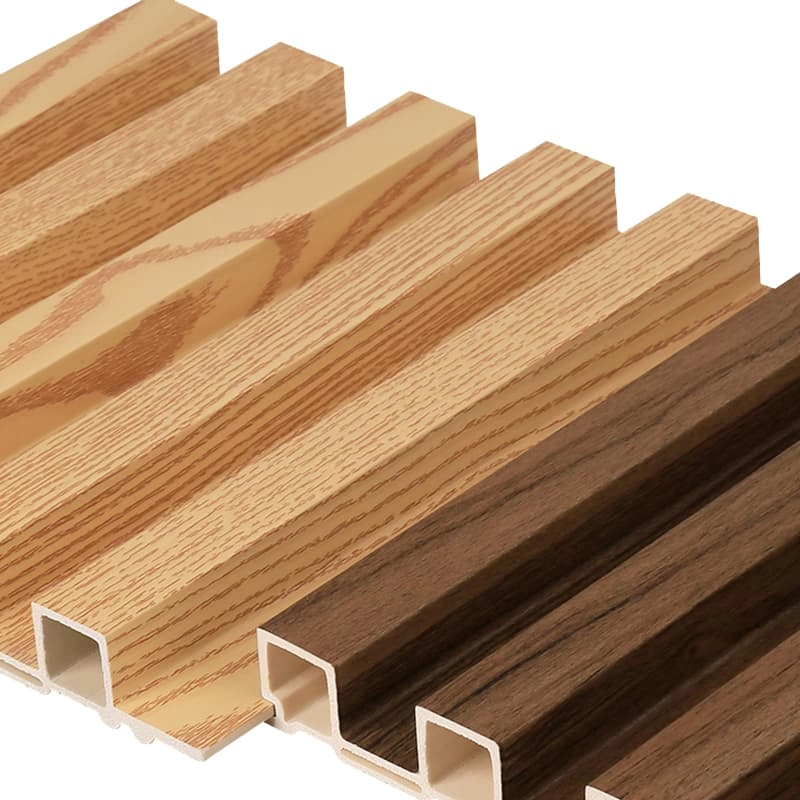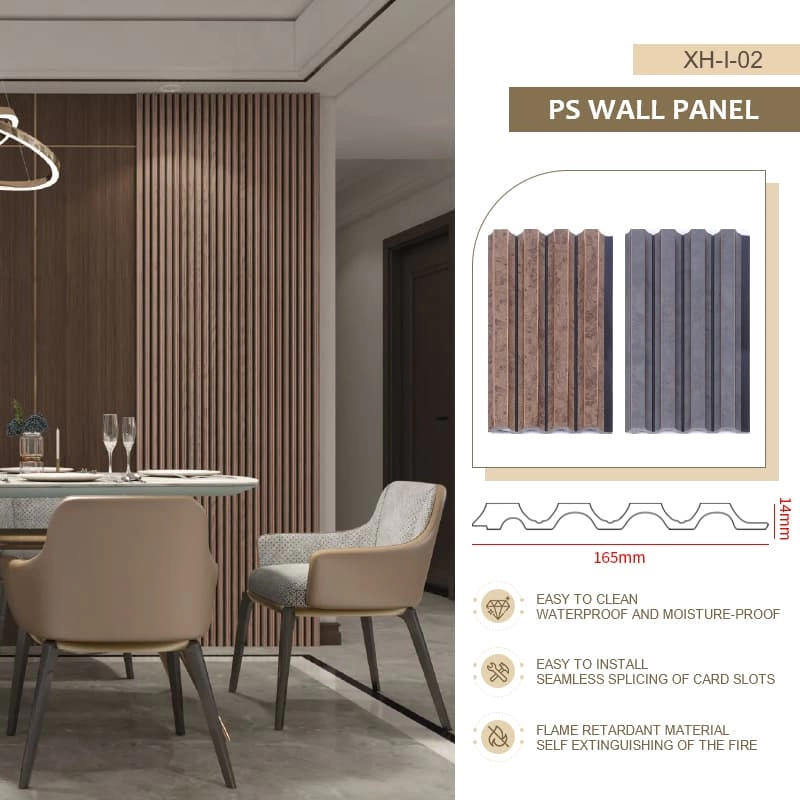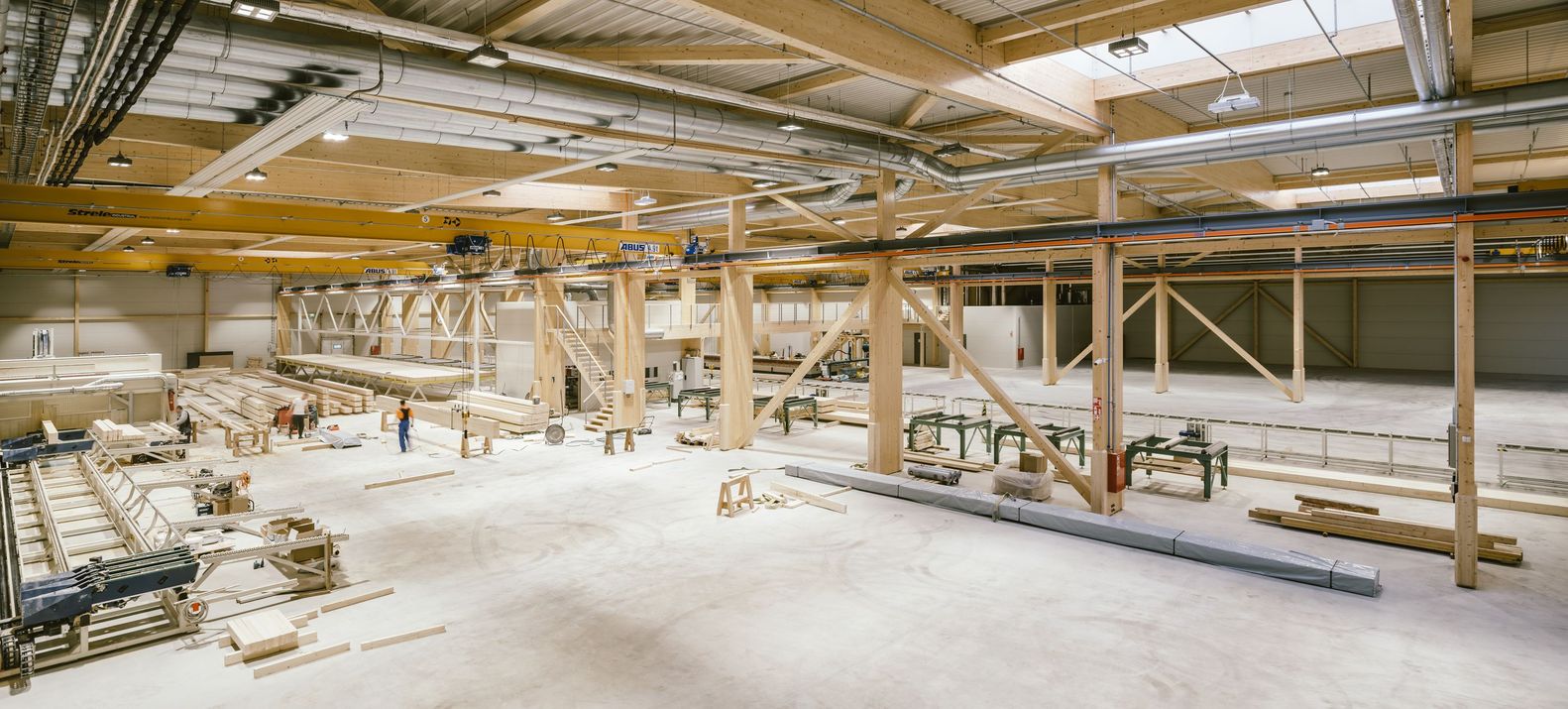CATEGORIES
WPC vs PVC Wall Panels: Unveiling the Key Differences in Composite Wall Cladding
Choosing the right wall panel for your project can feel like a big decision. With so many options out there, like WPC (Wood Plastic Composite) and PVC (Polyvinyl Chloride) wall panels, it's easy to get confused. You want something that looks great, lasts long, and fits your budget. As Allen, from a factory in China with 7 production lines, I've spent years helping customers like Mark Wilson from the USA understand these materials. This article will break down the difference between WPC and PVC wall panels, looking at everything from durability to environmental impact. We'll explore their unique features, helping you decide if WPC wall panels or PVC wall panels are the best fit for your construction, design, or retail needs. We want to make making the right choice easier for you!
1. What Exactly Are WPC Wall Panels and How Are They Made?
When we talk about a WPC wall panel, we're referring to a Wood Plastic Composite wall panel. Think of it as a clever mix of natural and man-made stuff. The "W" stands for wood, usually in the form of fine wood fiber or wood flour – often from recycled wood sources, which is great for the planet! The "P" stands for plastic, which includes various thermoplastics like polyethylene, polypropylene, or even PVC. These materials are blended together with some additives that help improve the wall panel's performance.
The making of a WPC wall panel is quite an interesting process. At our factory, we take these wood fibers and thermoplastics, mix them thoroughly, and then usually extrude them. Extrusion is like squeezing toothpaste out of a tube, but on a much bigger and hotter scale! This process shapes the mixture into the desired wall panel profile, whether it's flat for a sleek look or designed as wpc fluted wall panels for a textured effect. The resulting WPC panels are strong, durable, and offer some of the aesthetic warmth of natural wood without all the maintenance headaches. They are a fantastic option for various wall coverings.
These WPC wall panels are known for their robustness. The wood fiber gives them strength and a bit of rigidity, while the plastic component protects the wood from moisture and insects. This combination means your WPC wall panel can stand up to daily wear and tear much better than some traditional materials. They are designed to be a long-lasting solution for both interior and sometimes even exterior design applications, providing a reliable and attractive wall paneling material. The functionality of wall panels made this way is truly impressive.

2. And What Should I Know About PVC Wall Panels and Their Composition?
Now, let's switch gears to the PVC wall panel. PVC stands for Polyvinyl Chloride, which is a type of synthetic plastic polymer. You've probably encountered PVC in many forms, from pipes to window frames. When it comes to wall panels, PVC wall panels are made primarily from this versatile PVC resin. Unlike WPC, there's no wood fiber in a standard PVC wall panel. They are 100% plastic, which gives them some very specific characteristics.
The manufacturing of PVC wall panels typically involves extruding the polyvinyl chloride compound into specific shapes and sizes. These panels come in a variety of thicknesses and can be produced with a hollow core, making them very lightweight, or as solid sheets. The surface of a PVC wall panel can be finished in many ways – it can be smooth, textured, or printed with a huge array of designs, including realistic wood grain patterns or even marble effects, like those found in PVC marble laminate sheets. This makes them incredibly versatile for interior decoration.
One of the standout features of a PVC wall panel is its excellent water resistance. Because they are entirely plastic, they don't absorb water, which makes them a popular choice for wet areas like bathrooms and kitchens, or any space prone to moisture. They are also generally quite easy to clean. While they might not always have the same solid feel as a WPC wall panel, their lightness and ease of handling are big pluses for many installers and DIY enthusiasts. The PVC material is key to these properties.
3. What Are the Key Differences in Materials Between WPC and PVC Wall Panels?
Understanding the core material makeup is crucial when looking at the differences between WPC and PVC wall panels. The most fundamental key difference lies in their primary ingredients. A WPC wall panel is made from a composite blend of wood fiber (or wood flour) and thermoplastics (like PE, PP, or PVC). It's a hybrid material, aiming to combine the best of both worlds: the feel and look of wood with the durability and resistance of plastic. This wood-plastic composite gives WPC its unique characteristics.
On the other hand, a PVC wall panel is, as the name suggests, made predominantly of polyvinyl chloride (PVC), a synthetic plastic and pvc resin. There's no organic wood component in a standard PVC wall panel. This pure plastic composition means that PVC panels inherently possess qualities typical of plastics, such as high water resistance and a generally smoother, less porous surface compared to materials containing wood.
These compositional key differences directly influence almost every other aspect of the wall panels, from their weight and strength to their environmental impact and aesthetic possibilities. For instance, the wood fiber in WPC wall panels can provide a more substantial feel and a closer resemblance to natural wood, while the all-plastic nature of PVC wall panels makes them exceptionally good at repelling water. It's these core material distinctions that lead to the varied advantages and disadvantages of each wall panel type.
4. How Do WPC and PVC Wall Panels Stack Up in Terms of Durability and Strength?
When it comes to durability, both WPC and PVC wall panels offer good performance, but there are nuances. Generally, WPC wall panels are considered more robust and impact-resistant. The inclusion of wood fiber in their composite structure gives them added strength and rigidity. This means a WPC wall panel is often thicker than PVC wall panels and can better withstand accidental knocks, bumps, and the general wear and tear of busy environments. They are quite durable and can maintain their structural integrity for a long time. I've seen many projects where clients specifically prefer WPC wall panels for high-traffic commercial spaces because of this enhanced toughness.
PVC wall panels, while still durable, can sometimes be more susceptible to denting or damage from sharp impacts, especially if they are of a lighter gauge or have a hollow core structure. However, high-quality, solid PVC panels can be very resilient. Their strength often lies in their resistance to other factors like moisture and chemicals, rather than brute force. It's not that PVC wall panels aren't strong, but a WPC wall panel often has an edge in sheer physical robustness. So, while PVC wall panels have excellent resistance to certain elements, they might not always be as strong and durable as WPC wall panels in terms of impact.
It's also worth noting that the durability of any wall panel, whether WPC or PVC, heavily depends on the quality of manufacturing and the specific grade of materials used. As a factory owner, I always emphasize to clients like Mark that investing in a good quality wall panel from a reputable supplier pays off in the long run. A well-made WPC wall panel will certainly be more durable than PVC wall panels of a lower grade, and vice-versa. The thickest panels, often found in the WPC range, usually offer superior impact resistance.

5. Which Wall Panel Is Better for Wet Areas: WPC or PVC Water Resistance Compared?
This is a very common question, and the answer is quite clear: PVC wall panels generally take the crown for water resistance. Because PVC wall panels are made entirely of polyvinyl chloride, a non-porous plastic, they are virtually waterproof. They don't absorb moisture, swell, or warp when exposed to water, making them an ideal wall panel choice for high-humidity environments like bathrooms and kitchens, shower enclosures, and laundry rooms. This inherent property of the PVC material is one of its biggest selling points.
WPC wall panels, while significantly water-resistant, do contain wood fiber. Modern manufacturing processes for WPC wall panels involve encapsulating these wood fibers very well within the plastic matrix, which provides excellent protection against moisture. High-quality WPC wall panels perform exceptionally well in damp conditions and are far superior to traditional wood products. However, if a WPC wall panel were to be constantly submerged or if its protective surface were deeply compromised, there's a theoretical, albeit small, chance of some moisture affecting the wood fiber over a very long period. That said, for most practical applications, including bathroom walls (though perhaps not directly inside a shower stall without proper sealing), a good WPC wall panel offers more than adequate water resistance. Some might even argue they are more water-resistant than PVC wall panels in certain high-end formulations, but for absolute imperviousness, PVC is usually the go-to.
So, if your primary concern is creating a completely waterproof barrier, a PVC wall panel is often the safer bet. For areas with general humidity or occasional splashes, both WPC and PVC wall panels can perform well, but the 100% plastic nature of PVC gives it a natural edge in the most demanding wet applications. We supply a lot of PVC UV marble sheets precisely for these kinds of projects.
6. What is the Environmental Impact When Comparing WPC vs PVC Wall Panels?
The environmental impact is an increasingly important factor for many buyers, including those like Mark who are conscious of sustainability. When we compare WPC vs PVC wall panels, WPC wall panels often come out looking a bit greener. A significant reason for this is that many WPC wall panels utilize recycled wood fibers and recycled materials (plastics) in their composition. This helps to divert waste from landfills and reduces the demand for virgin timber. Furthermore, at the end of their life, some WPC panels can be recycled again, though the infrastructure for this varies by region. The wood-plastic composite itself is designed to be durable, leading to a longer lifespan and less frequent replacement.
PVC wall panels, on the other hand, have a more complex environmental profile. The production of polyvinyl chloride can be energy-intensive and involves chlorinated chemicals, which have raised environmental concerns in the past. While PVC is technically recyclable, the process can be challenging due to the variety of additives used in different PVC products, and not all recycling facilities are equipped to handle it. However, the industry is making strides in improving the sustainability of PVC, including increased use of recycled content and phasing out some of the more problematic additives. The longevity and low maintenance of PVC panels can also contribute to a reduced environmental impact over their lifecycle, as less frequent replacement means fewer resources consumed.
Ultimately, when considering the environmental impact, it's important to look at the entire lifecycle of the wall panel, from raw material sourcing and manufacturing to lifespan and end-of-life disposal or recycle options. For those prioritizing the use of recycled materials and a more "natural" component, WPC wall panels often present a more appealing profile, making them seem more environmentally friendly than PVC wall panels. My factory, for instance, focuses on sourcing sustainable components for our WPC wall panels to minimize our ecological footprint.
7. Aesthetics Showdown: How Do WPC and PVC Wall Panels Differ in Appearance?
The look and feel of your wall panel are, of course, super important! Both WPC and PVC wall panels offer a wide range of aesthetic options, but they cater to slightly different preferences. WPC wall panels, due to their wood fiber content, can achieve a look and texture that is remarkably close to natural wood. You can find WPC panels with deep wood grain patterns, various timber-like colors, and a warmth that many people associate with real wood. This makes them an excellent choice if you're aiming for a classic, rustic, or biophilic design. The appearance and functionality of wall panels made from WPC are a big draw for designers seeking that organic touch. Our XHH02 Factory Direct Waterproof Wood Alternative Ps Wall Panels With Fluted Design are a great example of this.
PVC wall panels, being entirely plastic, offer incredible versatility in terms of finishes. While they can also mimic wood grain, they truly excel in producing high-gloss surfaces, vibrant solid colors, and very convincing stone or marble effects. Think of shiny, modern kitchens or luxurious-looking bathroom wall coverings. PVC panels can be printed with intricate designs, allowing for a vast spectrum of decorative possibilities that might be harder or more expensive to achieve with WPC. The options for PVC include everything from subtle patterns to bold, statement-making graphics. For instance, the 3D UV marble sheets we produce offer a stunning, seamless marble look without the cost and weight of actual stone.
So, if a very authentic wood grain and feel are paramount, a WPC wall panel is often the preferred choice. If you're looking for high gloss, ultra-modern finishes, intricate patterns, or cost-effective marble and stone alternatives, PVC wall panels provide a broader canvas. The range of WPC panels is growing, but PVC's printing capabilities give it an edge in sheer design variety. Both wall panels are made to enhance your space, but their stylistic strengths differ.
8. Installation & Maintenance: Are WPC or PVC Wall Panels Easier to Handle?
Ease of installation and low maintenance are key benefits for both WPC and PVC wall panels, which is a big reason for their popularity. However, there are some slight differences. PVC wall panels are generally very lightweight, especially the hollow-core varieties. This makes them incredibly easy to handle, transport, and cut, often making the installation process quicker and simpler. Many PVC panels use a tongue-and-groove system, allowing them to click together seamlessly. For DIY projects or situations where speed is essential, PVC wall panels can be easier to install than WPC wall panels.
WPC wall panels, being a composite of wood fiber and plastic, are typically denser and therefore heavier than PVC wall panels. This added weight means they might require a bit more effort to lift and secure, and potentially a more robust fixing system depending on the specific WPC panel and the substrate. However, they are still far easier to install than traditional materials like ceramic tiles or solid wood planks. Many WPC wall panels also feature user-friendly installation systems. The wall paneling material itself is designed for efficient fitting.
When it comes to maintenance, both WPC and PVC wall panels are champions. They are non-porous (or very low porosity in the case of WPC), meaning dirt and grime don't easily penetrate the surface. A simple wipe-down with a damp cloth and mild detergent is usually all that's needed to keep them looking fresh. They don't require painting, sealing, or staining like natural wood. This low-maintenance aspect is a huge advantage, saving time and money over the lifespan of the wall panel. So, while PVC might be slightly easier to install than WPC due to weight, both offer significant advantages in easy care.
9. Safety First: What About Fire Resistance in WPC and PVC Wall Panels?
Fire resistance is a critical safety consideration for any building material, and this applies to both WPC and PVC wall panels. It's important to understand that neither material is inherently "fireproof" in the way that stone or metal might be. However, both WPC and PVC wall panels can be manufactured with fire-retardant additives to improve their performance in the event of a fire. These additives help to slow down the spread of flames and reduce smoke production.
As a manufacturer, I, Allen, know that meeting safety standards is paramount. Reputable suppliers will have their wall panels tested and certified according to international fire resistance ratings (e.g., ASTM E84 in the USA, or various EN standards in Europe). When Mark Wilson is sourcing wall panels and pvc wall products, or wall panels and wpc wall products, checking for these certifications is one of his key concerns, and rightly so. It's crucial to ensure that the wall panel you choose meets the building codes and safety requirements for its intended application.
Generally, PVC material itself can be self-extinguishing, meaning it may stop burning once the heat source is removed, depending on its formulation. WPC wall panels, containing wood fiber, might behave differently without fire retardants, as wood is combustible. However, with the right treatments, both types of panels and pvc wall panels or panels and wpc wall panels can achieve good fire safety ratings. Always ask your supplier for documentation regarding fire resistance and ensure the products are suitable for your specific project needs. This is an area where cutting corners is never an option.
10. Making the Call: When Should You Choose WPC Wall Panels Over PVC, or Vice Versa?
So, after exploring all these differences between WPC and PVC wall panels, how do you make the final decision? Choosing between WPC and PVC wall panels really comes down to your specific needs and preferences, project requirements, and budget. There's no single "best" wall panel – it's about finding the best fit.
You might prefer WPC wall panels over PVC if:
- Aesthetics: You desire a wall panel with a very authentic natural wood look and feel. WPC fluted wall panels, for example, offer a sophisticated, textured appearance that's hard to replicate.
- Durability: You need a more robust wall panel for high-traffic areas or environments where impacts are more likely. The inherent strength of the wood-plastic composite makes WPC wall panels very durable.
- Environmental Concerns: You prioritize using materials with recycled wood content and a potentially lower environmental impact.
- Feel: You prefer a wall panel that feels more solid and substantial. WPC wall panels are generally thicker than PVC wall panels.
Conversely, PVC wall panels might be the better choice if:
- Water Resistance: Absolute waterproofness is critical, such as in shower stalls or very damp commercial kitchens. PVC wall panels are made of PVC, which is inherently impervious to water.
- Budget: You're working with a tighter budget. While not always the case, PVC panels can sometimes be more cost-effective, especially for large projects.
- Ease of Installation: You need the lightest possible wall panel for quick DIY installation or in situations where structural load is a concern. PVC wall panels are typically used where lightweight solutions are ideal.
- Specific Finishes: You're looking for high-gloss finishes, vibrant colors, or very specific printed designs like detailed marble or stone effects. The options for PVC in this regard are vast. For example, our general Professional Plywood and Wall Panel Supplier page showcases a variety of finishes.
For a procurement officer like Mark Wilson, the decision often involves balancing quality, aesthetics, durability, price, and supplier reliability. He knows that for some projects, the richness of a WPC wall panel is ideal, while for others, the practicality and specific finishes of a PVC wall panel are a better match. As Allen, my goal is to provide clear information and high-quality options in both WPC and PVC wall panels so that my clients can confidently make the right choice for their unique applications.
Key Takeaways: WPC vs PVC Wall Panels
Here's a quick recap of the most important things to remember when comparing WPC and PVC wall panels:
- Composition: WPC wall panels are a wood-plastic composite (wood fiber + plastic), while PVC wall panels are made primarily of polyvinyl chloride (plastic).
- Durability & Strength: WPC wall panels are generally more robust and impact-resistant due to their wood fiber content, often being thicker than PVC wall options.
- Water Resistance: PVC wall panels offer superior, inherent waterproof qualities, ideal for very wet areas like bathrooms and kitchens. WPC wall panels are highly water-resistant but not always fully waterproof in extreme conditions.
- Environmental Impact: WPC wall panels often have a better environmental impact profile due to the use of recycled wood and plastics, and can be easier to recycle.
- Aesthetics: WPC wall panels excel at mimicking natural wood grain and texture. PVC wall panels offer vast versatility in finishes, including high gloss, marble, and diverse printed patterns.
- Installation: PVC wall panels are typically lighter and can be easier to install than WPC wall panels. Both are low maintenance.
- Fire Resistance: Both can be treated for fire resistance, but always check certifications.
- Cost: Prices vary, but PVC panels can sometimes be more budget-friendly, though quality WPC wall panels offer excellent long-term value.
- Making the Right Choice: Your decision between WPC vs PVC wall panels depends on your specific project needs, aesthetic desires, budget, and performance requirements.
I hope this detailed comparison helps you navigate the world of WPC and PVC wall panels! If you have any more questions or need advice for your next project, don't hesitate to reach out.





